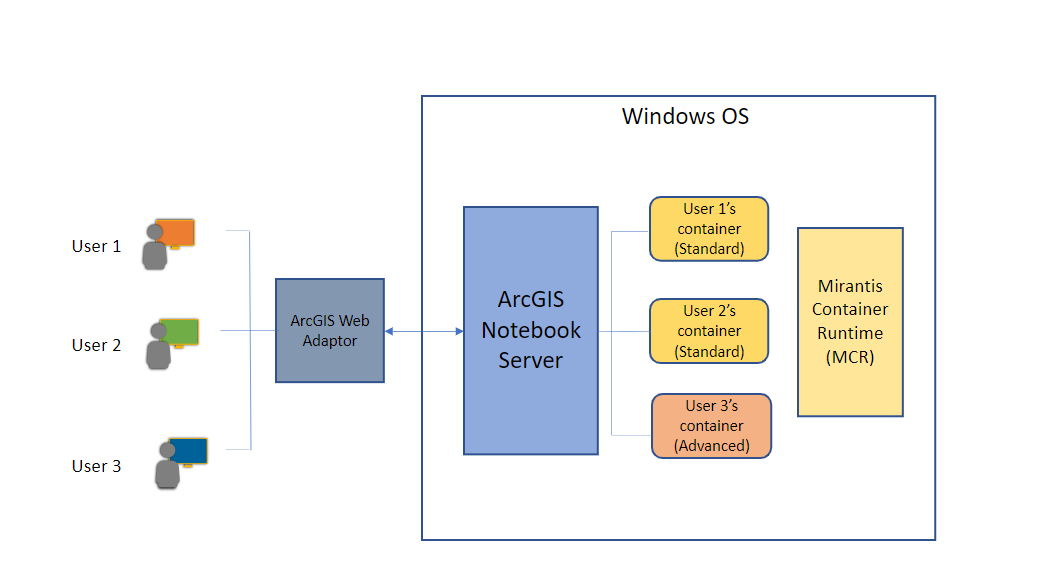ArcGIS Notebook Server on Windows Server can now utilize Mirantis Container Runtime.
Mirantis Container Runtime for Windows
Similar to other ArcGIS Notebook Server deployments, ArcGIS Notebook Server with Windows containers is installed on a server operating system and is configured and federated with an ArcGIS Enterprise portal. Additionally, a web adaptor can be deployed in front of the ArcGIS Notebook Server software.
ArcGIS Notebook Server uses virtualized operating systems known as containers to isolate notebook authors' environments. As a result, the containers allow each author to use a subset of server resources without their work or resource usage interfering with others.
These containers are allocated and maintained by Mirantis Container Runtime, formerly Docker Engine Enterprise, a third-party software component. Before installing ArcGIS Notebook Server, you must install Mirantis Container Runtime. Once ArcGIS Notebook Server is installed, it must be configured to work with Mirantis Container Runtime.
ArcGIS Notebook Server allocates one container per runtime to each notebook author on the site, and only they can work in the container. The computing resources the authors use when running notebooks will not affect other authors' containers.
When a portal member with corresponding privileges opens their first notebook, a container is launched on the ArcGIS Notebook Server site. This session between the notebook and the container will be ongoing through the duration of the notebook.
ArcGIS Notebook Server can join multiple machines together in a site. Machines in a multiple-machine configuration must be configured to be identical, and each machine can run ArcGIS Notebooks.
Notebook runtimes and Windows container images
Esri provides a single Windows container image for ArcGIS Notebook Server. This container image includes the Standard and Advanced notebook runtimes, which make Python resources available in ArcGIS Notebooks. See Available Python libraries for more information on the libraries available in each runtime.
The two ArcGIS Notebook Server runtimes, Standard and Advanced, are available in notebooks as part of the container image. Depending on your license and user privilege, either the Standard or both the Standard and Advanced runtimes will be available for use.
The Windows containers in an ArcGIS Notebook Server site support two modes of runtime isolation, process and Hyper-V. See the Microsoft documentation on Isolation Modes for more information on the modes. If you configure your site to use Hyper-V isolation, the Hyper-V role must be installed on the machine.
Note:
There are limitations with respect to the number of containers that can be run when using Windows containers with Hyper-V. See this Microsoft FAQ for more information.


When a container is launched, the Windows container image provided by Esri is applied to the container. The runtime will depend on the license configured for ArcGIS Notebook Server and the notebook author's privilege.
Note:
There is a known limitation that may result in WinError 1455 when importing the torch library or Python libraries that have torch as a dependency. See Common problems and solutions for more information.
Prerequisites and constraints for Windows systems
If you deploy ArcGIS Notebook Server on Windows machines with windows containers, there are prerequisites and constraints to consider.
Mirantis Container Runtime prerequisites
- Mirantis Container Runtime currently only supports Windows Server 2022.
- When ArcGIS Notebook Server and Mirantis Container Runtime are deployed on multiple machines, you no longer need to configure replication (DFS) for your workspace directory. The workspace directory can be shared as a path mounted on a drive with Mirantis Container Runtime.